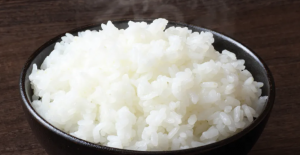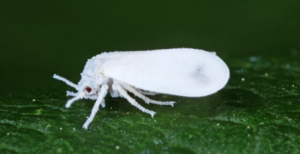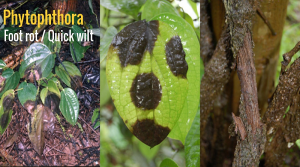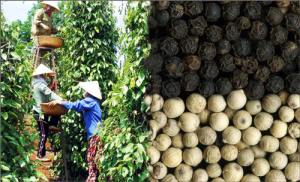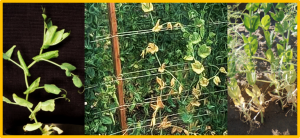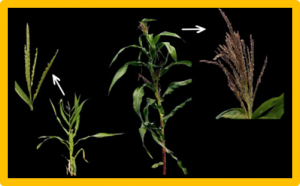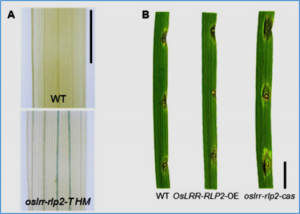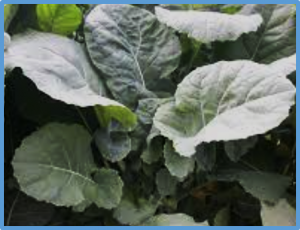Fruit rind color is an important agronomic trait that affects commodity quality and consumer choice in zucchini (Cucurbita pepo). However, the molecular mechanism controlling rind color is unclear. We characterized two zucchini inbred lines: ‘19’ (dark green rind) and ‘113’ (white rind). Genetic analysis revealed white immature fruit rind color to be controlled by a dominant locus (CpW).
Prime editing is a versatile CRISPR/Cas-based precise genome-editing technique for crop breeding. Four new types of prime editors (PEs) named PE6a–d were recently generated using evolved and engineered reverse transcriptase (RT) variants from three different sources. In this study, we tested the editing efficiencies of four PE6 variants and two additional PE6 constructs with double-RT modules in transgenic rice (Oryza sativa) plants.
Trade-offs between evolutionary gain and loss are prevalent in nature, yet their genetic basis is not well resolved. The evolution of insect resistance to insecticide is often associated with strong fitness costs; however, how the fitness trade-offs operates remains poorly understood. Here, we show that the mitogen-activated protein kinase (MAPK) pathway and its upstream and downstream actors underlie the fitness trade-offs associated with insecticide resistance in the whitefly Bemisia tabaci.
Phytophthora capsici and P. tropicalis are the two species of Phytophthora associated with foot rot disease of black pepper in India. High genetic diversity amongst the Phytophthora species contributes to its wide host range and variability in the virulence pattern. In the present study, genetic diversity of Phytophthora species infecting black pepper was analysed using RAMS (Random Amplified Microsatellites) and REP (Repetitive Extragenic Palindromic)-PCR fingerprinting.
Piper nigrum L. (black and white peppercorn) is one of the most common culinary spices used worldwide. The current study aims to dissect pepper metabolome using 1H-NMR targeting of its major primary and secondary metabolites. Eighteen metabolites were identified with piperine detected in black and white pepper at 20.2 and 23.9 μg mg-1, respectively. Aroma profiling using HS-SPME coupled to GC-MS analysis and in the context of autoclave treatment led to the detection of a total of 52 volatiles with an abundance of β-caryophyllene at 82% and 59% in black and white pepper, respectively.
Pea Fusarium wilt, incited by Fusarium oxysporum f. sp. pisi (Fop), has always been a devastating disease that causes severe yield losses and economic damage in pea-growing regions worldwide. The utilization of pea cultivars carrying resistance gene is the most efficient approach for managing this disease. In order to finely map resistance gene, F2 populations were established through the cross between Shijiadacaiwan 1 (resistant) and Y4 (susceptible). The resistance genetic analysis indicated that the Fop resistance in Shijiadacaiwan 1 was governed by a single dominant gene, named FwS1. Based on the bulked segregant analysis sequencing analyses,
Doubled haploid (DH) line production through in vivo maternal haploid induction is widely adopted in maize breeding programs. The established protocol for DH production includes four steps namely in vivo maternal haploid induction, haploid identification, genome doubling of haploid, and self-fertilization of doubled haploids. Since modern haploid inducers still produce relatively small portion of haploids among undesirable hybrid kernels
Rice is an important cereal crop worldwide, the growth of which is affected by rice blast disease, caused by the fungal pathogen Magnaporthe oryzae. As climate change increases the diversity of pathogens, the disease resistance genes (R genes) in plants must be identified. The major blast-resistance genes have been identified in indica rice varieties; therefore, japonica rice varieties with R genes now need to be identified.
Circular RNAs (circRNAs), a class of non-coding RNA molecules, are recognized for their unique functions; however, their responses to herbicide stress in Brassica napus remain unclear. In this study, the role of circRNAs in response to herbicide treatment was investigated in two rapeseed cultivars: MH33, which confers non-target-site resistance (NTSR), and EM28, which exhibits target-site resistance (TSR).
In 1967, in this journal, Evelyn Witkin proposed the existence of a coordinated DNA damage response in Escherichia coli, which later came to be called the “SOS response.” We revisited this response using the replication inhibitor azidothymidine (AZT) and RNA-Seq analysis and identified several features. We confirm the induction of classic Save our ship (SOS) loci and identify several genes, including many of the pyrimidine pathway, that have not been previously demonstrated to be DNA damage-inducible.


 Curently online :
Curently online :
 Total visitors :
Total visitors :

